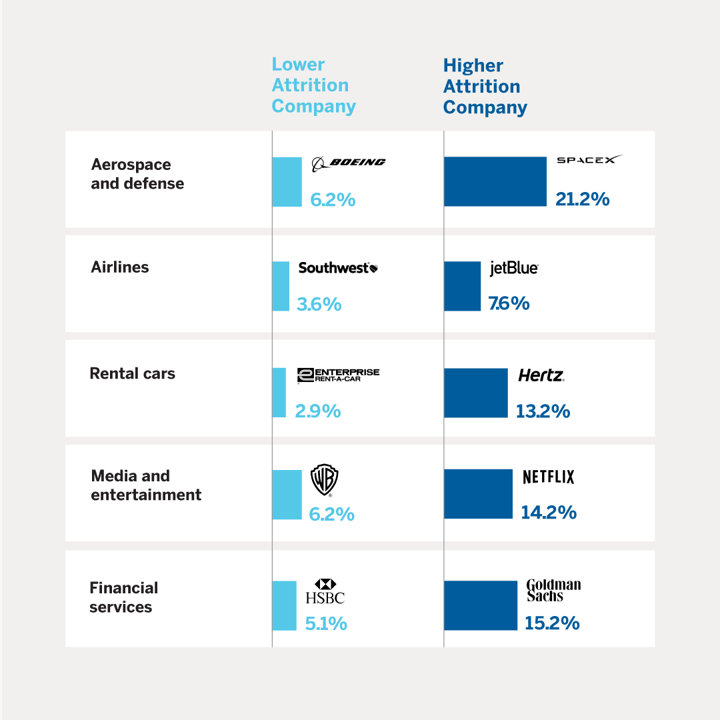How Toxic Culture Is Making Us Quit
New insights on the great resignation | 4-min read
As one of nearly 50 million Americans who quit their job in the past year, I have been fascinated with any and all things "Great Resignation." Luckily (for me), there have been hundreds of personal stories, stats, and articles on the topic printed and published all over the internet. What's not so lucky (for anyone who loves facts) is that the coverage lacks data. Though we know how many are quitting, the questions of who is resigning and why are addressed mainly by opinion and anecdote.
So, in my admittedly obsessive quit-rate trend-tracking, I was thrilled to unearth a new study that sheds some much-needed, data-driven light on these unanswered questions. The research, compiled and published at MIT, tells us not only why people are quitting, but what organizations can do about it.
And while I'd love to make this academic study required reading for anyone who's ever had a job, I thought it much more impactful (and realistic) to summarize the key points and share my own two cents on the blog.
Behold, below, the latest facts on the Great Resignation and what companies can (and should) do about it.
It's real.
More than 40% of employees surveyed at the start of 2021 reported that they were actively considering leaving their jobs. This was followed by a sharp uptick in the "quit rate" – the percentage of the workforce leaving their jobs – starting in April 2021. In absolute terms, this amounted to over 24 million US employees quitting their jobs over the six months between April and September alone.
So, yes, the great resignation is real.
For you visual learners, behold the chart below:
Source: Bureau of Labor Statistics
All the collars are quitting.
There have been two competing narratives in the media about who exactly is quitting. One strain (pandemic pun intended) points to blue-collar workers in industries like retail and hospitality who are saying "no more" to unlivable wages and poor working conditions. A second focuses on burnt-out knowledge workers (aka the office-dwelling, white-collar workforce) in search of a more meaningful life.
The data shows both narratives are true.
There are, of course, many more nuances and stories raising the quit rate within each group, but the key takeaway is that the Great Resignation is transcending sectors and income levels.
Resignation rates vary by industry.
Unsurprisingly, resignation rates vary by sector. Among those studied by the authors, the lowest quit rate was recorded in the airline industry (5%) and the highest in apparel retail (19%). Many factors contribute to these variations: industry growth, wage levels, gender, and race diversity, among others – all of which have a significant impact on working conditions and, as a result, retention.
But companies have some control…
The more fascinating fact is that resignation rates vary between companies within the same industry. In other words, companies with the right policies and practices can overcome larger, structural challenges within their industry and create environments where people are less likely to leave.
The study cited several compelling examples of companies within the same sector with wildly different retention rates over the past few months (see below). In media and entertainment, Warner Brothers (WB) saw a quit rate of 6.2% vs. Netflix at 14.2%; in financial services, a sector notorious for burnout (and very high salaries), HSBC recorded a quit rate of 5.1% vs. Goldman Sachs at 15.2%.
So what is it that WB or HSBC are doing right that Netflix and Goldman get wrong?
Toxic culture is the #1 problem.
It turns out that the clearest predictor of attrition – and by a large margin – is toxic corporate culture. According to the research, employees consider a toxic workplace 10.4 times more important than compensation when deciding to leave or stay.
In this study, "toxic culture" is characterized by key ingredients:
Failure to promote diversity, equity, and inclusion
Workers feeling disrespected
Unethical behavior
This isn't just about workers saying "enough" to unhealthy workplaces; it's about workers being unable to survive in workplaces and organizations that don't provide the support, resources, and flexibility employees need. The data tells us another thing: promoting equity, diversity, and inclusion is not just a corporate perk; it has become a necessary means of talent retention and company survival.
This explains why women have been quitting at higher rates than men, citing insufficient support for childcare, eldercare, and other responsibilities that disproportionately fall on females.
Myth-busting: We aren't trading the cubicle for the couch.
One of the biggest misconceptions about the Great Resignation is that it's largely a wave of entitled workers trading in the cubicle (or fast food counter) for long hours on the couch. This is reinforced by narratives blaming a "lazy" workforce or the benefits of stimulus checks, but the reality is that most workers are quitting jobs to take other, better jobs. (A little-known fact about the quit rate is that it includes people leaving one role for another, not just people opting out of the workforce entirely).
For organizations, this means that the cultures, policies, and approaches they espouse play a massive role in retaining and attracting talent, or as I prefer to call them, people.
For the Curious…
Toxic Culture Is Driving the Great Resignation
MIT | 12-min read
We Quit: Pulling the Plug on Unhappy Work
Melina's Out of Office | 4-min read
How Toxic Work Cultures Are Driving the Great Resignation
Dare to Lead Podcast (Brené Brown) | 1-hr listen
Everyone Is Quitting. Here's the Right Way to Do It
New York Times | 10-min read
What to Do When All Your Employees Want to Leave
Wall Street Journal | 7-min read or listen



